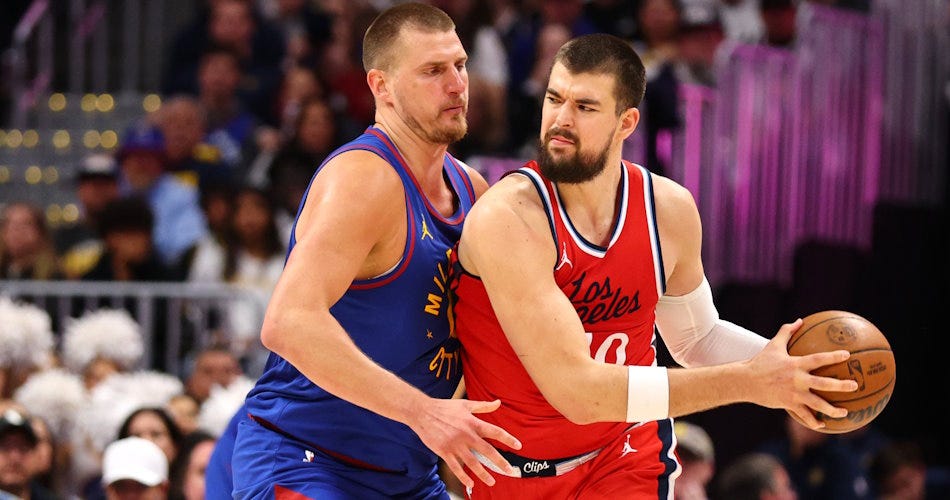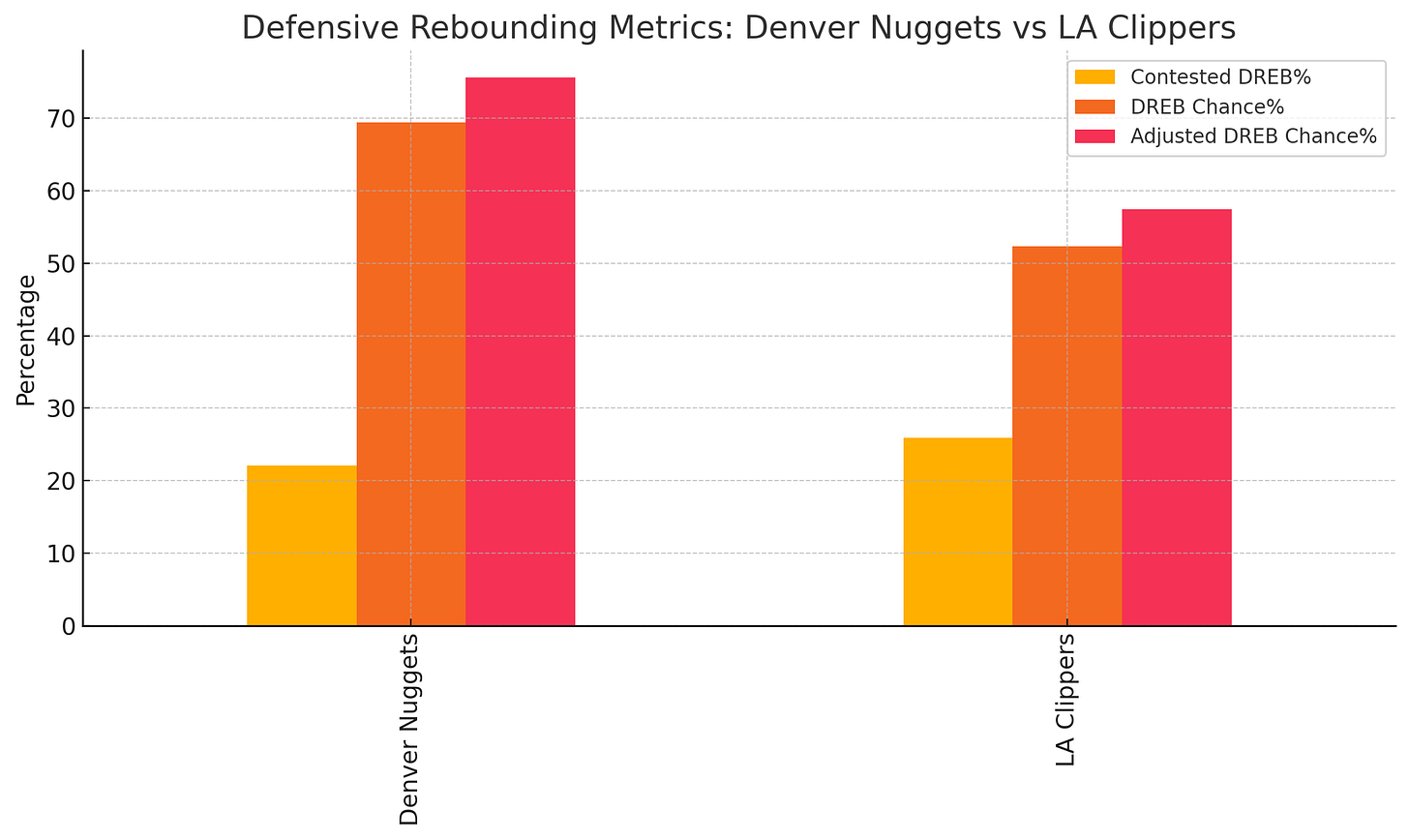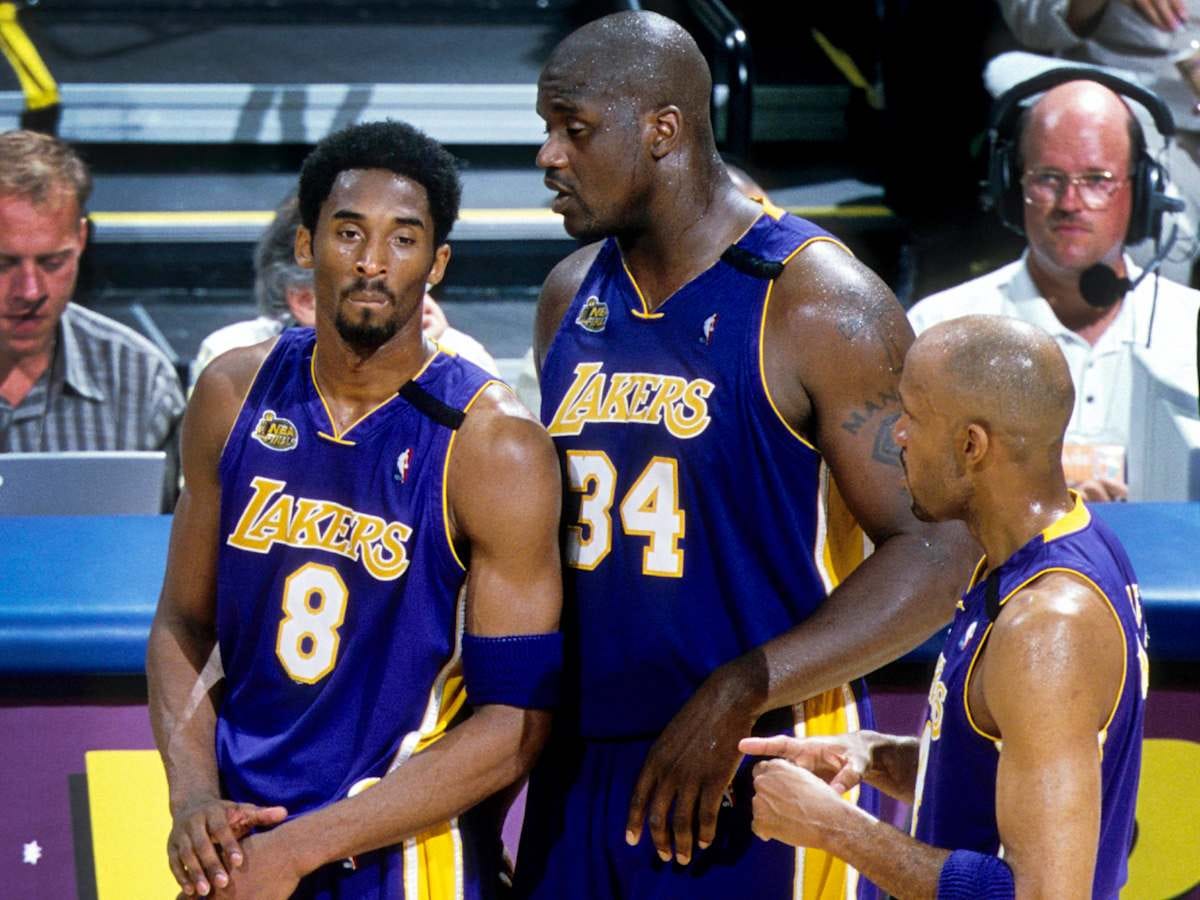The NBA playoffs started off with a bang - there have been a lot of great games, interesting schemes, and outlook changes. Here are two series that have been interesting to me so far.
Clippers vs. Nuggets:
Round one usually gives us a couple heavyweight fights, and this year has been no different. The parity outside of the top 3 or so teams this year has resulted in a competitive cluster in the Western Conference, where the Nuggets and Clippers settled into a competitive Game 1 and 2. Stylistically, the series projected to be interesting - outside of the Thunder, no team is crafted better to handle Nikola Jokic and co. for a seven game series than the Clippers. Boasting Ivica Zubac—who’s in the midst of the most impactful stretch of his career—a fully healthy Kawhi Leonard, and Kris Dunn (second in the league in defensive EPM at +3.5), the Clippers have the defensive personnel needed to contain this Denver team.
We’ve seen their defensive strategy before - while the 2024 Timberwolves opted to take Jokic out of pick and rolls by utilizing Gobert as a roamer and Naz Reid or KAT as a primary matchup - the Clippers have operated more similarly to the 2023 Heat, who attempted to crowd passing lanes and focus on forcing Jokic turnovers less than denying Jokic the ball outright.
The difference between this Clippers team and the 2023 Heat - and what makes this series interesting - is that they have the personnel for this task. Zubac has anchored a top 3 defense all season, and rather than make Jokic play post-hub actions, the Nuggets have tried to bring Zubac out of the paint and move Jokic into the initiator role. But overall, the results have been a mixed bag. The Nuggets have found success in some of these actions, running inverted pick and rolls without Zubac on the backline to protect the rim (first clip) , but have crowded these slips and baseline cuts with Harden (who is secretly having the best “hands” season of his career), Kawhi Leonard, Kris Dunn, and Norman Powell (second and third clip). The lateral quickness of these defenders combined with their hands has made Denver stuffy for reasons other than its altitude.
Jokic’s creation, for lack of a better word, has been called ‘inevitable’ - and that has held up in the last four or so seasons - but there are certainly schemes/locations where the burden can be put on the agility or catch radius of Jokic’s teammates. 7 turnovers, compared to his average of 2.5, for Jokic (5 of which were bad pass) doesn’t necessarily spell complete disaster for the Nuggets, but I’m guessing there will be more two man actions with Murray and Jokic the next game - which can help with bringing Zubac out of the paint and giving the Clippers less anticipation time on slips or cuts on the weak side.
Meanwhile, the Clippers have found a lot of success in transition crossmatching, where they can really exploit Jokic’s lack of rim protection in the pick and roll.
Just analyzing the Clippers personnel, there are lots of reasons to think the Nuggets would have trouble or likely lose this matchup - but it’s not exactly for the exact reasons people think. Zubac isn’t necessarily pulverizing Jokic, but the Nuggets will need to find other ways to rotate around the Joker in order to sustain him playing level in drop coverage.
In this possession, Watson should be placed on the Clippers’ worst shooter, in order to bother Zubac on the pass and give Jokic a little more time to trap Zubac down low. Westbrook, even with a high motor, isn’t going to bother Zubac on these catches.
But the Nuggets, who split these exciting games, have had their own strengths that have kept Game 1 and 2 relatively even.
The Nuggets, despite the loss, benefited from Jokic’s gravity in offensive and defensive rebounding in Game 2. Westbrook, MPJ, and Gordon are all tremendous rebounders for their positions, and Jokic is wisely sitting a few feet back from the basket so that the other Nuggets can effectively crowd Zubac and their own man on these opportunities. These opportunities allowed the Nuggets to claw their way back in Game 1, and allowed MPJ to contribute better in Game 2.
And this isn’t to say there aren’t areas of improvement for the Clippers. With Zubac on the floor and Jokic on the bench, the Clippers can’t afford to let Michael Porter Jr. or Gordon to just get in on the play, unless they anticipate another Kawhi Leonard aimbot performance.
Ultimately, I swing the Clippers in this series - but more than anything, I want to see five more of these games. So all around, hoping for some brilliance on both sides.
Wolves vs. Lakers:
The Wolves-Lakers series started off with a different, but equally fascinating, punch - one in which I was left questioning whether my pre-series prediction of the Lakers coming out on top was correct.
I feel weird writing this, partially because the Lakers are currently blowing the Wolves out in Game 2. But ultimately, I still trust my mid-series switch-up and think the Wolves will lead the series in shot quality and that will translate to a win as well.
Some of the reasons for that aren’t just the Lakers’ lack of defensive personnel - that seems to be the idea floated around on Twitter (at some point, I need to get with the times and call it X, but not today). While that’s true to an extent, the Wolves advantage extends further to their own defensive coverages.
In Game 1, the Wolves found success playing the Lakers “Big 3” straight-up. Small ball (if we can even call what the Lakers are doing that) has reached an almost detrimentally “good” connotation in basketball spaces, especially when Rudy Gobert is involved against it. But the truth is simple - Gobert isn’t AS bad as he’s made out to be on switches - and LeBron (at this age) isn’t a good enough lateral or herky-jerky driver to really bother Gobert downhill.
Even when the Lakers briefly “found” matchups they wanted, the Wolves have enough big wing, mobile defenders and can hedge players that make switching tricky for the Lakers. Furthermore, the Wolves having secondary rim protection at multiple positions (Edwards, Jaden McDaniels, Naz Reid, Nickeil Alexander-Walker) makes rolling or slipping even more delicate for the Lakers.
In this play, Vincent acts out a switch, but Randle doesn’t bite. Knowing McDaniels is there to bother LeBron on the other side, Randle doesn’t need to necessarily accept his fate. Dorian Finney-Smith then brings Conley up - but Edwards stays attached to Vincent, which prevents DFS from rolling, and allows Conley to briefly hedge, and when Conley backs up, the entire play is broken, and the Lakers end with a Vanderbilt drive (not my idea of efficient offense).
A separate play sees the Lakers trying to switch Conley onto LeBron at the elbow, which works briefly, but all three of the other Lakers being stuck in the same spot allows Naz Reid to sit off a little bit as the rim protector, which means Randle can deny the switch again and Conley can gamble on the steal. The Timberwolves having big, active, defensive personnel limits the Los Angeles’ ability to create any matchup advantages.
This isn’t to say the Lakers can’t find other ways to exploit the Timberwolves. Luka has continued success against Jaden McDaniels, similar to last year’s Western Conference Finals, but the lack of a real lob threat certainly constrains some of the actions the Lakers can create from.
Really though, the Lakers can try to force more decision making out of Edwards by overloading the strong side and daring the lesser of the Timberwolves’ pretty good shooters to shoot. Game 1 was tough for that, but probably unsustainable, in that Jaden McDaniels, Mike Conley, and Naz Reid finished a combined 11/14 on threes, and Randle was able to assume some more of the primary decision making abilities (part of why the Timberwolves traded for him). But shooting variance and some purposeful shading might leverage Randle into settling for those typical not so fun to watch self-created jumpers, and that’s why I say the series will be closer than what happened in Game 1.
I lean Timberwolves, but Redick has impressed me with some creative coverages this season. While most of them have revolved around ball denial, there might be some ways to really exploit some of the decision making issues the Wolves have had.
A Small Update:
I took a pretty long break after my last article, so if you’re wondering whether more content is coming (or even if you totally forgot I existed) - this is usually the time of the season things heat up for me!
I plan on getting more NBA Draft content out - particularly my thoughts on Cooper Flagg but also Collin Murray-Boyles, Kon Knueppel, and breaking down some of the young NBA players who move me. This summer SHOULD be rich in content, or at the very least, presence. I like to think that last summer was the 2000 Lakers and this summer should be the 2001 iteration. Or last summer was the 2013 Spurs and this summer should be the 2014 Spurs. You get it. Positivity.
If you enjoyed this breakdown, subscribe! And if you want to shoot me some questions or schedule a meeting, feel free to reach out.
Email: joseph.a.george@gmail.com
Schedule a meeting here (click on the here).








